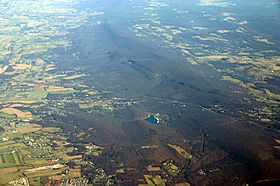Monterey Pass facts for kids
Quick facts for kids Monterey Pass |
|
|---|---|
| aliases: Monterey, Monterey Gap, Monterey Springs |
|

South Mountain, with Monterey Pass at top of photo.
|
|
| Elevation | ~1300 ft |
| Traversed by | Old Pennsylvania Route 16 |
| Location | Washington Township, Franklin County, Pennsylvania |
| Range | South Mountain |
| Coordinates | 39°44′09″N 77°28′28″W / 39.73583°N 77.47444°W |
| Topo map | USGS |
Monterey Pass is a mountain pass about 1,300 feet (around 400 meters) high. It is located in Franklin County, in southern Pennsylvania. This natural gap in the mountains has been important for travel and, historically, for military movements.
Contents
Where is Monterey Pass?
The lowest part of the pass, called the saddle area, is found near Happel's Meadow. It sits between two peaks: Monterey Peak (1,663 feet high) and Clermont Crag (1,627 feet high). These peaks are part of the South Mountain Range. This range is also part of the larger Blue Ridge Mountains System.
Monterey Pass is close to a town called Blue Ridge Summit. It is also near the famous Mason–Dixon line, which is the historic border between Pennsylvania and Maryland.
Monterey Pass in History
Monterey Pass played a role in the American Civil War. It was the site of a battle in July 1863, known as the Fight at Monterey Pass. This fight happened during the Retreat from Gettysburg, when Confederate (Southern) troops were moving away from the Battle of Gettysburg.
Early Skirmishes
The first military action at Monterey Pass took place on June 22, 1863. A group of Confederate cavalry, led by Captain Robert B. Moorman, was sent to find horses. They traveled through Maryland and Pennsylvania.
At Monterey Pass, Moorman's troops met Union (Northern) cavalry units. These included Bell's Adams County Cavalry and the First Troop Philadelphia City Cavalry. After a short fight, the Confederate soldiers pulled back. They joined a larger Confederate force led by General Richard S. Ewell.
Other small battles happened in the area before the main Battle of Gettysburg. For example, there was a fight at Fairfield on June 21. There were also skirmishes involving Pennsylvania militia at Fountain Dale on June 28 and at Emmitsburg, Maryland, on June 24.
The Fight at Monterey Pass
The main battle at Monterey Pass happened on July 4–5, 1863. On July 4, other skirmishes also took place nearby. These included a fight at Fairfield Gap, Pennsylvania, and small clashes near Emmitsburg, Zora, and Waynesboro. Even as late as July 8, Union forces were still in the area.
A historical marker, like a stone tablet, describes the movements of troops on July 4, 1863:
East Cemetery Hill
Tablet 6 of 9
July 4, 1863
First and Second Brigade, First Cavalry Division marched from
Westminster The Reserve Brigade First Cavalry Division from
Gettysburg en route to Frederick Second Brigade Second Cavalry
Division from Westminster via Emmitsburg to Monterey The Third
Brigade Second Cavalry Division from Gettysburg to Hunterstown and the
Third Cavalry Division from Gettysburg via Emmitsburg to Monterey
Skirmishes at Fairfield Gap Pennsylvania and near Emmitsburg Md

